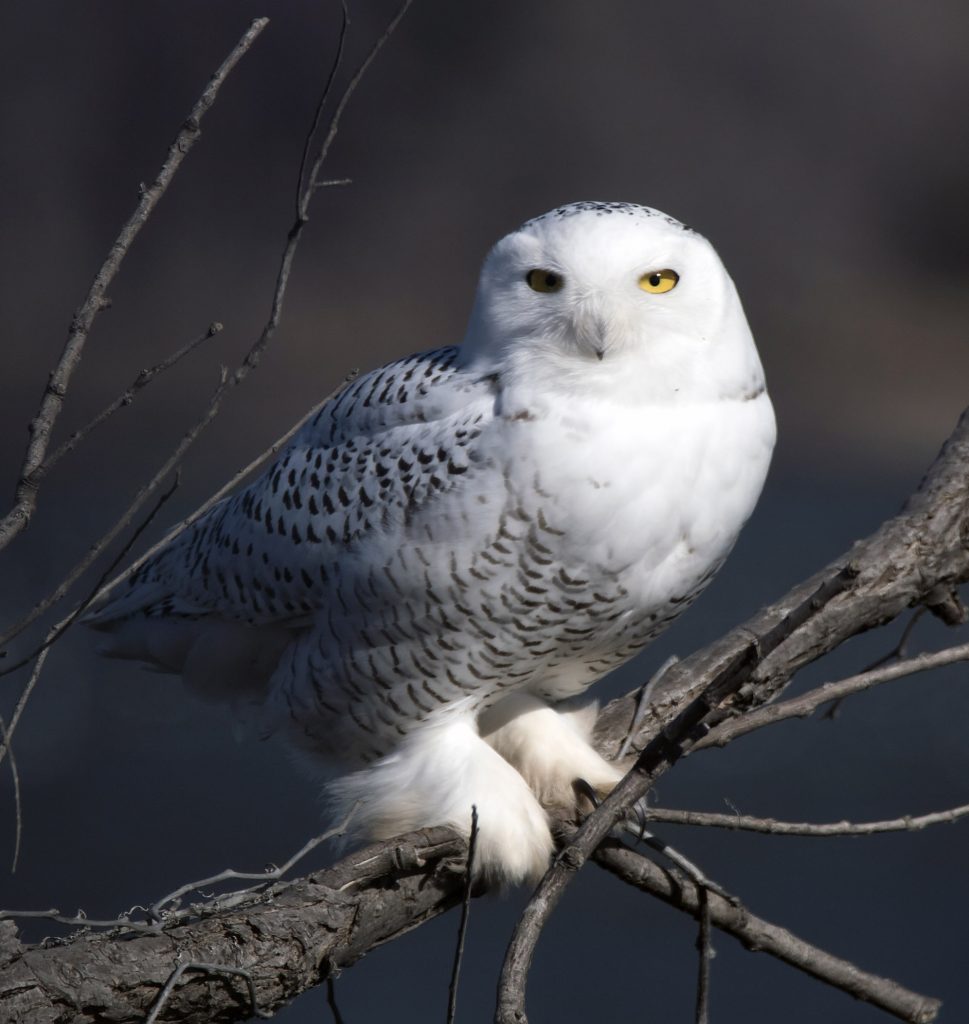By John Shackford

When discussing the Snowy Owl (Bubo scandiacus), a good place to start is on its breeding grounds, in the high arctic; it is circumpolar, and after its breeding season, many move southward in both Eurasia and North America.
The owl lays from 3 to 13 eggs, but usually about 6 or 7. Like many birds of prey, the owls will stagger egg laying (laying a new egg about every day and a half), and incubation starts immediately after the first egg is laid. This means the older eggs hatch first and these nestlings have a better chance of survival than the smaller, younger ones.
Food for the nesting owls is usually lemmings, small rodents that undergo boom and bust cycles about every 3-4 years; arctic hares, another food, also cycle in the high arctic. As these lemming/hare cycles peak, Snowy Owl populations also tend to peak. But when the lemming/hare populations crash in the far north, the owls may end up searching for food far south of their usual wintering grounds in Canada, sometimes coming all the way south to Oklahoma and Texas. This winter seems to be another invasion year of Snowy Owls in Oklahoma, with several owls already reported.
Up until about 1974 Dr. George M. Sutton believed that most or all of the Snowy Owls showing up in the state did not survive the winter; this opinion was based on the fact that most Snowy Owl records in Oklahoma before 1974 were in early winter, with very few, if any, records in late winter, suggesting poor survival of the owls in late winter. But then the winter of 1974-75 arrived, with the largest invasion of Snowy Owls ever recorded in Oklahoma; that winter there were thirty some sightings, and Dr. Sutton felt these represented at least 20 different owls.
Of the three specimens found dead that winter, Dr. Sutton noted none “had obviously died of starvation, nor had any of the living birds appeared to be in poor condition” (J. S. Shackford. 1975. The snowy owl in Oklahoma, Bulletin of the Oklahoma Ornithological Society 8: 29-34); thus I believe Dr. Sutton softened his position somewhat on Snowy Owls being able to survive the winter in Oklahoma.
Nonetheless, Nathan Kuhnert’s caution seems wise: that most of these birds likely show up in Oklahoma quite stressed for food and energy and thus observers should be extremely careful to not “push” them.
On 10 December 1974, I was driving to Norman to visit Dr. Sutton. Along Interstate Highway 35, near the Norman Airport, I saw a large, light breasted bird dead on the side of the road. I thought it might be a Ferruginous Hawk; imagine my surprise when it turned out to be a Snowy Owl. I immediately took it to Dr. Sutton who prepared a beautiful skin; he found the bird to have a gangrenous right leg, but otherwise in nearly perfect feather.
The amount of daylight when Snowy Owls hunt is an interesting question. Because it nests in “the land of the midnight sun,” it must be able to hunt in daylight, especially when there is a nest full of hungry young. Then, in winter, birds staying far to the north would need to be able to hunt at night, because of little or no sunlight at that time of year. Thus, the species must be flexible in the amount of sunlight it has when it hunts.
From 6 January to 14 February 1975, a very white, small, and therefore an adult male Snowy Owl was found in Canadian County, far northwest Oklahoma City, by Henry Walter, and J. S. Robert, former members of our club. This owl I followed almost daily from 22 to 29 January, being careful, I believe, not to force the owl to fly unnecessarily. I found the owl had a preferred field in the center of its range, a short grass field where I suspected a good population of cotton rats. The owl’s overall territory seemed to cover grass and wheat fields in an oval about 3.5 miles long and 1 mile wide; from its preferred field, the bird went north in the daytime, then apparently southward from that field at night. I spent a lot of time in the daytime just watching the bird. I learned that this owl, so lethargic during daylight hours, became a very active, strong hunter about half an hour before sunup and likewise in the evening after sundown, often hover hunting its preferred field quite methodically. I have never seen such an abrupt change in behavior in any other owl species.
